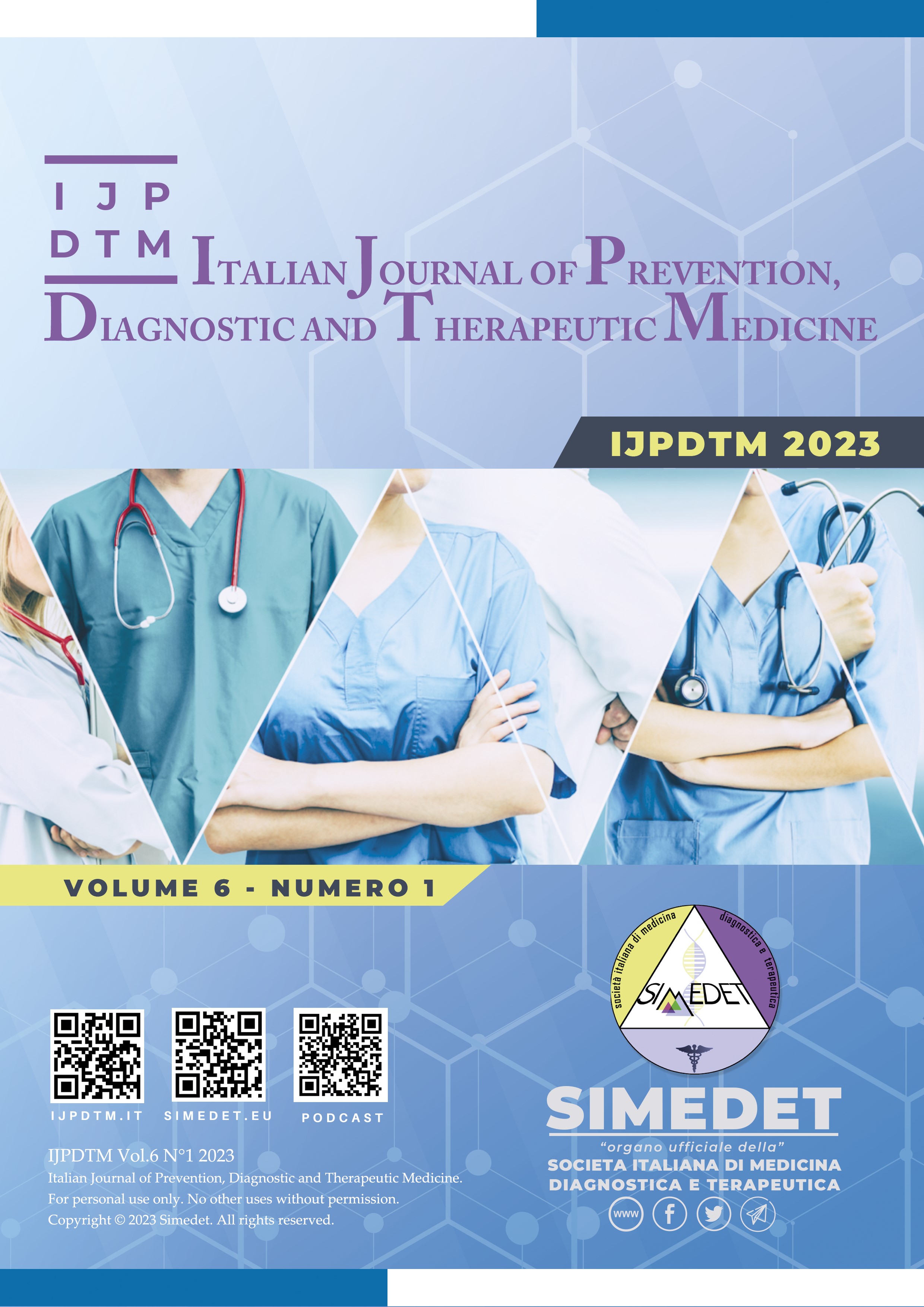Analysis of the use of the closed tracheal suction system by nurses in ICU
Main Article Content
Abstract
BACKGROUND
Tracheal suctioning is one of the most common procedures performed in intensive cares units (ICU) that ensures airway patency and a good ventilator pattern in patients with OT tube or tracheostomy. This procedure can be carried out by two different devices: an open tracheal suction system (OTSS) and a closed tracheal suction system (CTSS), each with its own peculiarities.
After an analysis of the scientific literature, which supports the use of the CTSS, it was decided to conduct research in the intensive care units of Brotzu’s and Duilio Casula’s hospitals of the city of Cagliari, to analyse the actual use of the device by nurses, highlighting difficulties and doubts. The CTSS has always been the subject of discussion among nurses in ICU.
MATERIALS AND METHODS
The research study was carried out by performing random face-to-face interviews of nurses during data collection.
The interview consisted of eleven questions. At the same time, random observations of the CTSS’s use were made, using the Duilio Casula Hospital ICU’s protocol as a guide.
RESULTS
It was clear that the CTSS is used extensively, even daily. 62,5% of nurses believed that the CTSS was more effective, and 62,5% of the interviewed nurses reported using the device in all intubated and tracheostomy patients. However, 41,3% of nurses reported not using the device beacuse it was believed to have a lower suction capacity.
The observation’s results highlighted mistakes such as poor hand hygiene (89,5% of the observations), a failure to disconnect the probe from the suction system (63,15%), and repeated insertion of the probe (31,6%), and poor manual skills using the device (15,8%).
CONCLUSIONS
The analysis of the results highlighted how nurses had a good theoretical knowledge of the CTSS, but have been observed a lot of mistakes in the use of the device.
This suggests to consider the organization of practical re training courses in the intensive care units.
Downloads
Article Details

This work is licensed under a Creative Commons Attribution-NonCommercial-NoDerivatives 4.0 International License.
References
Imbriaco, G., & Monesi, A. (2021). Closed tracheal suctioning systems in the era of COVID-19: is it time to consider them as a gold standard? In Journal of Infection Prevention (Vol. 22, Issue 1, pp. 44–45). SAGE Publications Ltd. https://doi.org/10.1177/1757177420963775.
Raimundo, R. D., Sato, M. A., da Silva, T. D., de Abreu, L. C., Valenti, V. E., Riggs, D. W., & Carll, A. P. (2021). Open and closed endotracheal suction systems divergently affect pulmonary function in mechanically ventilated subjects. Respiratory Care, 66(5), 785–792. https://doi.org/10.4187/RESPCARE.08511.
Naiara Matilde, I., Rakel Ferreira, R., Vedovato, A., Maria Freire Vieira Lima, N., Castilho de Figueiredo, L., Dragosava, D., Marques Tonella, R., & Isabela Morsch Passos, A. (2017). Comparação dos Efeitos Hemodinâmicos e Respiratórios no Uso dos Sistemas de Aspiração Traqueal Aberto e Fechado Comparison of Hemodynamic and Respiratory Effects in the Use of Open and Closed Tracheal Suctioning Systems. In J Health Sci (Vol. 19, Issue 2).
Khayer, F., Ghafari, S., Saghaei, M., Yazdannik, A., & Atashi, V. (2020). Effects of open and closed tracheal suctioning on pain in mechanically ventilated patients. Iranian Journal of Nursing and Midwifery Research, 25(5), 426. https://doi.org/10.4103/ijnmr.ijnmr_135_18.
Ebrahimian, A., Tourdeh, M., Paknazar, F., & Davari, H. (2020). The effect of the open and closed system suctions on pain severity and physiological indicators in mechanically ventilated patients with traumatic brain injury: A randomised controlled trial. Turkish Journal of Anaesthesiology and Reanimation, 48(3), 202–207. https://doi.org/10.5152/TJAR.2019.03342.
Coppadoro, A., Bellani, G., & Foti, G. (2019). Non-pharmacological interventions to prevent ventilator-associated pneumonia: A literature review. In Respiratory Care (Vol. 64, Issue 12, pp. 1586–1595). American Association for Respiratory Care. https://doi.org/10.4187/RESPCARE.07127.
Ardehali, S. H., Fatemi, A., Fariba Rezaei, S., Forouzanfar, M. M., & Zolghadr, Z. (2020). The Effects of Open and Closed Suction Methods on Occur-rence of Ventilator Associated Pneumonia; a Comparative Study. In Archives of Academic Emergency Medicine (Vol. 8, Issue 1). http://journals.sbmu.ac.ir/aaem.
Hlinková, E., Nemcová, J., & Bielená, K. (2014). CLOSED VERSUS OPEN SUCTION SYSTEM OF THE AIRWAYS IN THE PREVENTION OF INFECTION IN VENTILATED PATIENTS. Cent Eur J Nurs Midw, 5(2), 63–710.
de Seta, D., Carta, F., & Puxeddu, R. (2020). Management of tracheostomy during COVID-19 outbreak: Heat and moisture exchanger filter and closed suctioning system. In Oral Oncology (Vol. 106). Elsevier Ltd. https://doi.org/10.1016/j.oraloncology.2020.104777.
Kumar, N., Singh, K., Kumar, A., & Kumar, A. (2021). Unusual cause of hypoxia due to incomplete removal of the closed suction catheter system during COVID-19 ventilation. In Journal of Clinical Monitoring and Computing (Vol. 35, Issue 6, pp. 1529–1530). Springer Science and Business Media B.V. https://doi.org/10.1007/s10877-021-00695-z.
Ruan, S. Y., Lin, F. C., Huang, C. T., Ku, S. C., & Wu, H. D. (2015). Effect of incomplete withdrawal of a closed-suction catheter on airway resistance. In Intensive Care Medicine (Vol. 41, Issue 8, pp. 1496–1497). Springer Verlag. https://doi.org/10.1007/s00134-015-3886-y.

